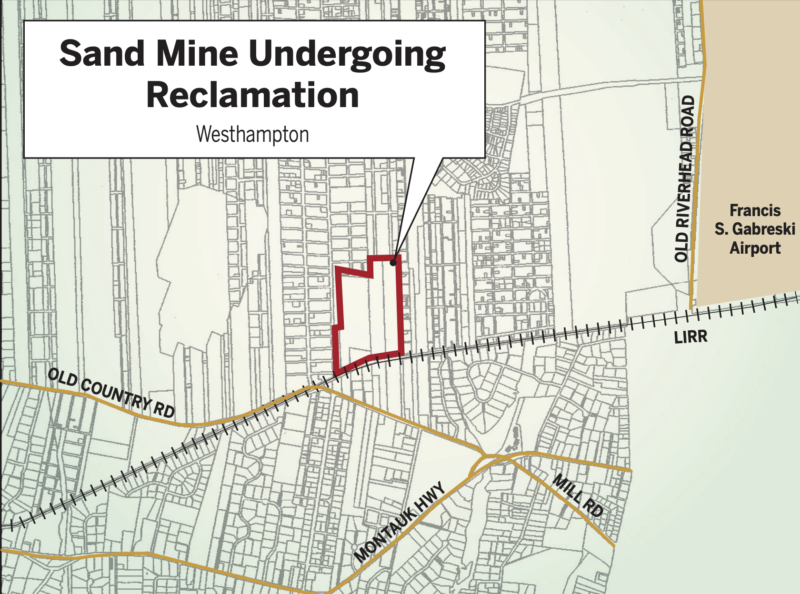
What can a sand mine be when it’s no longer mining sand?
That’s the question members of the Southampton Town Board began to grapple with when the new owners of the former Westhampton Mining Aggregates site, Grant Hendricks and Frank Amicizia, visited its Thursday, April 28, work session.
Accompanied by Town Planning and Development Administrator Janice Scherer, the owners’ representatives George Duke of Brown, Duke & Fogel, P.C. and Kris Almskog, of P.W. Grosser began a process of brainstorming new uses and zoning for the property, located on seven parcels comprising 47 acres on North Summit Boulevard in Westhampton.
The goal of the discussion, Scherer said, was to develop a preliminary understanding of how officials can look at the reclamation of the mine.
In the past, the town had zoning tools like planned development districts that might have been useful for the site’s redevelopment, offering an overlay zoning designation, but the controversial PDD legislation was repealed in 2017. The Comprehensive Plan suggested that a portion of the property be used for recreational purposes.
Board members will have to consider two parallel issues: what to do with sand mines when they’ve run out their useful life and how can they be reclaimed in a way that’s sustainable and meets the town’s renewable energy goals, plus what can be best for the particular property brought to the table.
The town’s Geographic Information System notes four sand mines in Westhampton located off Old Country Road.
The parcel under discussion is adjacent to the Long Island Rail Road tracks and close to an electrical substation, described by Scherer as two very ideal parameters for sustainable redevelopment such as solar arrays or battery storage.
The property owners are reclaiming the land under the purview of the State Department of Environmental Conservation and can’t reclaim the property back to grade until DEC knows what they’re going to do with it, Scherer explained. They have no path forward, she underscored, because there’s nothing permitted under zoning beyond 5-acre residential development.
“This is a unique opportunity,” Scherer continued, “because here you have a situation where we are looking for places for renewable energy, for solar arrays, where we’re not trading green for green, not clearing trees.”
The acreage could be suitable for battery storage, or allowing for composting or making the soil amendment biochar, or other types of energy programs.
The goal is finding a sustainable use that won’t create a lot of traffic. Considering the mine, Scherer offered, “You’re in a hole — it’s possible to build things without anybody knowing you’re there.”
The property is no longer operating as a sand mine, though some soil piles were left behind by previous owners. The new owners will be moving the soil, Duke explained; restoring the site will entail moving a lot of material, and his client is negotiating a consent order to allow certain activities to take place to fill up the hole.
Soil on the site has to be handled under the jurisdiction of DEC. Almskog reported about 20,000 yards of material will leave the site and the rest is suitable for reuse. Sampling profiles of piles left behind, the DEC carved out portions that need to be removed.
It’s rare to have a suitable site in a hole, Duke pointed out. There’s an opportunity to ensure anything built is “somewhat subdued” and less impactful to neighboring properties.
Their clients are “absolutely” amenable to the types of uses Scherer mentioned. The land’s location a quarter mile from the Westhampton transfer station, just east of it, makes it nicely suited for solar or battery storage systems, Scherer said.
How about an ATV park? Councilwoman Cynthia McNamara suggested. A location below grade could contain noise and possibly help curtail the illegal riding of ATVs on area trails.
The town’s Comprehensive Plan notes the property could be suitable for an ATV park or campgrounds. Though at 47 acres, Scherer didn’t feel the entire site would be used for recreation.
There’s no clear path for the redevelopment of a mine property, Scherer reiterated. A new zoning designation would include a table of uses, all of which would be allowed after special exception review. The board could create an industrial reclamation zone — land being reclaimed would go under that code and lists of uses. Many of the sand mine sites are quite large, Scherer said, they could host a number of synergistic uses.
There’s an opportunity for an enterprise zone, with a table of options that would put unproductive properties into productive use, Deputy Supervisor Francis Zappone observed. That zoning could cover a range of suggestions, he said. Warehouses and a greenhouse distribution type of use have been mentioned.
She asked the board to begin to consider uses that might fit. Councilman Rick Martel wondered if it could be suitable for light industrial uses. The town is low on contractor storage sites, Scherer affirmed.
While the majority of the properties surrounding the North Summit Boulevard parcels are commercial, the land is located in the core preservation area of the Long Island Pine Barrens. The Central Pine Barrens Commission would have to weigh in on any proposed development. The use was preexisting, Scherer pointed out, years ago, “This was no-man’s land.” She’s going to work on developing a code, then provide the developers with a framework against which to make a proposal.
Town officials have spent a lot of time trying to get renewable energy resources within the community and, said Zappone, “it’s a difficult process.” He welcomes a partnership that sees private ownership and the town working together. Opportunities are growing and the DEC actively supports purposeful reuse of disturbed landfills or mines, the deputy supervisor pointed out. They encourage putting the property back into useful production commensurate with the needs of the community.